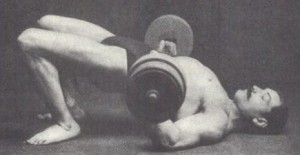Pullover and Push: Old School “Bench Pressing”

Pullover and Push as demonstrated by the great Arthur Saxon. He was a favorite of JWC "founding father" Dalton Jackson
by Thom Van Vleck
Those of you who know me know that I can’t make things simple. I put a lot of thought into things and when I was thinking about lifts for the 2011 USAWA Nationals to be held June 25th in Kirksville, Missouri this process was in overdrive. I wanted a pressing movement and I also wanted a lift that would honor my grandfather in some way. Well, he was a big fan of Arthur Saxon and when I saw this photo in the USAWA photo archive it just sealed the deal for me that the Pullover and Push would be that “pressing” movement in the list of lifts for Nationals.
Let’s review the rules to make sure we know how to do the lifts!
The lifter will lie on his/her back on the platform with the bar placed on the platform above the lifter’s head. Padding, such as a towel or mat, may be placed under the lifter’s body and elbows. The bar is gripped with the palms of the hands facing up and with the bar at arms’ length prior to the start of the lift. Width of hand spacing and feet placement is optional. The lift begins at the lifter’s discretion. The lifter is allowed multiple rolls with the bar on the platform to gain momentum to the bar. Hands must remain on the bar throughout the lift. The lifter will then pull the bar over and onto the chest or upper abdomen resulting in the upper arms resting on the platform. The bar must not be rolled once on the chest. The bar or plates must not make contact with the platform once the bar leavesthe platform or it will result in disqualification. The lifter is allowed to move or lift the feet and hips during the pullover. Once the bar is on the chest or abdomen, the lifter may move the feet close to the hips, and raise the hipsto create a bridging or belly toss to propel the bar to arms’ length. This is done at the lifter’s discretion. The lifter is allowed feet and hip movement during the push. The lifter may press the bar instead of pushing the bar if desired. Once the push has begun, the bar must not be lowered in any manner. Only one attempt at the push is allowed. The bar must lock out with even extension. Once the arms are straight, the lifter must lower the hips to the platform and straighten the legs to a flat position on the platform. The arms must remain straight during this time. When the lifter and bar are motionless, an official will give a command to lower the bar. The lift ends when the bar is returned to the platform under control. It is acceptable to drop the bar behind the head in the return to the platform as long as the lifter maintains hand contact with the bar.
Now, you have to make sure you distinguish this lift from the Pullover and Press and the Pullover and Press with Wrestler’s Bridge. They are often confused. The last thing I will say is that if you have a big nose or a big head…..you may want to turn your head when you pull the weight over to the push position! If you’ve ever done this lift, you know what I mean! Now, come to the Nationals and try it first hand!